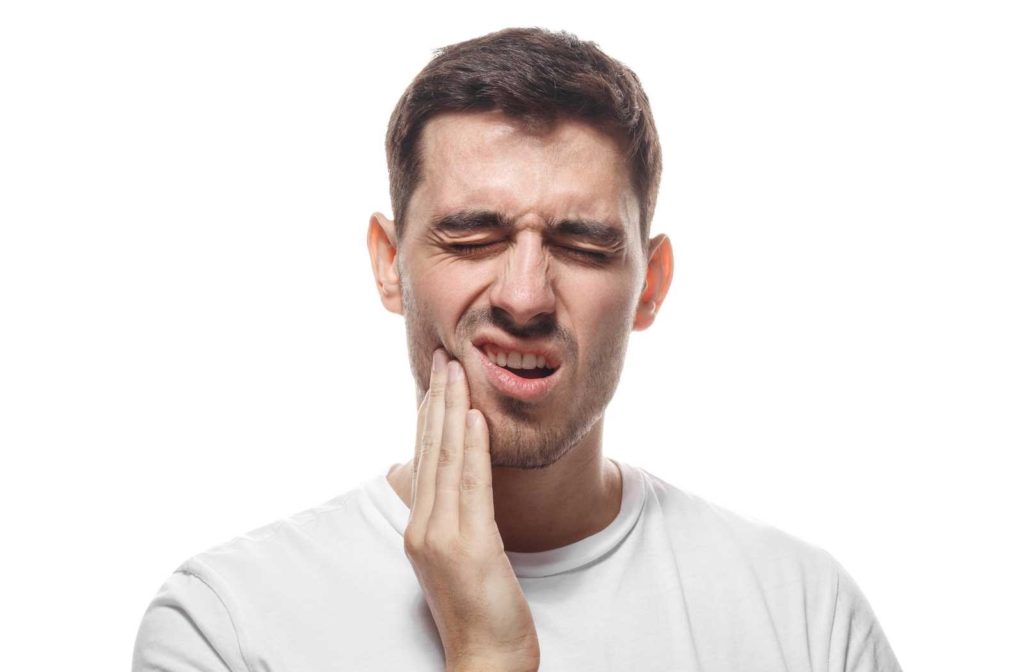Having sensitive teeth can affect many people, but it can have wildly different causes. When a patient complains about sensitive teeth typically, it can be caused by issues with their gums or the surface of their teeth. But when a patient opts for teeth whitening, the cause, the prevention, and the treatment of sensitive teeth can vary.
Overall sensitive teeth can be linked to issues with your gums and teeth. But some patients have something called dentin hypersensitivity, and getting a teeth whitening treatment can trigger it.
Dental Stains & Whitening
Your teeth are made up of several layers, and staining can affect several of them. On the outside of a given tooth is a layer called enamel. Enamel is a hard, mineralized material that protects the tooth from heat and hard substances.
Underneath that layer is dentin, a solid but porous material with hollow channels (called tubules) leading to the core of the tooth, where blood vessels and nerve endings in the pulp chamber underneath convey nutrients to the outer layers of the tooth. These tubules also conduct heat and pressure to your nerves.
Stains often come from colour-pigmented foods like coffee, tea, wine, sports drinks, hard candies, various berries, and tomato sauce can all impact your enamel — causing extrinsic, and ultimately intrinsic staining. The same is true of chewing or smoking tobacco.
Depending on the stain’s extent and whether the staining is surface level or a little deeper — professional or at-home teeth whitening can work tooth stains out quickly and efficiently. Whitening works well on the enamel of your tooth, but deeper stains can require more care.
Extrinsic Staining
This type of staining comes when pigments or chemical residue from smoking embed into microscopic cracks in the enamel. Removal of these stains is relatively easy. But if tooth decay cuts through the enamel, extrinsic stains can become intrinsic — as pigments and chemicals pour through the breaches in the enamel and filter into your tooth’s dentin.
Intrinsic Staining
Proper intrinsic staining comes from within, however. It’s not pigments or chemicals from food, drink, or smoking — but chemicals from within the body that discolour the dentin after blood vessels in the pulp of the tooth deposit them there.
Some of the standard intrinsic staining we see can be traced to excessive fluoride intake or antibiotic consumption (including tetracycline and liquid amoxicillin) in infancy. Black teeth are often a result of deadened nerves and blood vessels in the pulp of the tooth. Some genetic conditions result in intrinsic grey stains. And ageing can naturally darken your dentin into yellow and brown hues.
These types of total stains can’t really be helped by whitening procedures, so we might recommend a crown to cover the stained dentin. But if the stain only reaches the visible surfaces of the dentin, whitening can help.
How Whitening Works
Tooth whitening can vary a lot in expense, effectiveness, and how it works. Many over-the-counter gels, bleaching strips, and even chewing gums can help to different degrees.
But the basic idea is to remove pigments and chemicals from the enamel or dentin if it’s not too deep and intrinsic. A dentist can tailor a whitening treatment to you, so you can achieve an attainable shade without sacrificing the enamel of your teeth.
Which Types of Whitening to Avoid
Of all the various whitening methods, the ones we recommend least are those that use abrasives. Abrasive materials most often found in whitening toothpastes (or chewing gums) actually work by scraping stains off with fine particles.
The trouble is that abrasion usually takes enamel away with the stains, so your teeth’s dentin becomes overexposed with prolonged use. In that case, your tooth sensitivity can be more permanent and conventional than sensitivity due especially to whitening.
Whitening Methods Using Bleaching
Bleaches remove pigments without rubbing them away. The enamel is better preserved, meaning you’ll have a lower risk of cavities and permanently sensitive teeth. Professional teeth whitening uses sophisticated bleaching techniques to safely change your dental shade.
But whether over-the-counter or by professional means, some of the most effective active ingredients include hydrogen peroxide — a bleaching agent. Some patients experience a unique teeth sensitivity to hydrogen peroxide, however. These patients are affected by whitening due to their dentin hypersensitivity. The good news is, once these patients finish the course of their whitening treatment, the sensitivity tends to subside.
Non-Bleaching Methods
If your dentist learns of your sensitivity to bleaching, they may suggest other whitening methods. They can do a touch-and-air test to determine whether you have dentin hypersensitivity and whether bleaching might disturb your dentin. In that case, they can avoid or minimize hydrogen peroxide use.
How Whitening Can Lead to Sensitivity Due to Whitening
Sensitivity can affect your teeth before, during, or after the use of hydrogen peroxide-based teeth whiteners. This sensation frequently occurs during the early stages of bleaching treatment when the hydrogen peroxide soaks through your enamel, rattling the dentin’s nerves beneath it.
But 80% of sensitivity comes from the gum line if it’s due to whitening — which is understandable because the gums have more substantial nerve endings than those tucked away inside your teeth.
They may also retreat a little in response to your nerves’ perceived trauma coming from bleaching. Enamel doesn’t extend that far beneath the gum line, and covering the dentin on the roots of your teeth is a different material, called cementum. Cementum is hard, but it doesn’t insulate your teeth against heat and pressure as well as enamel.
How to Decrease Tooth Sensitivity Due to Whitening
Some patients respond differently to bleaching. You or your dentist can do several things to counteract teeth sensitivity due to whitening (A.K.A dentin hypersensitivity):
- Use a lower concentration of the whitening product.
- Reduce the amount of tray bleaching wear time.
- Increase the time between individual bleaching treatments.
- Avoid whitening for an extended period.
- Use a desensitizing treatment or varnish applied chairside in the dental office.
- Prescribed gel or toothpaste for tooth sensitivity.
- Gentle brushing with a soft-bristled brush, using lukewarm water.
- Change diet by avoiding hot or cold foods for a day or two after whitening.
- Avoid excessive use of at-home whitening treatments.
- Use desensitizing agents 10 to 30 minutes prior and after each bleaching.
- Use bleaching products with added desensitizing agents.
Over the course of whitening treatments, you can resume your dental exams and cleanings as usual. Your dentist will probably recommend fluoride at your next dental exam or dental cleaning. Fluoride helps remineralize the enamel of your tooth, so you can enjoy decreased sensitivity. A thicker, healthier enamel can better protect your teeth against plaque, heat, and pressure.
Your Whitening Process Your Way
If you go for professional whitening, your dentist can help lessen the adverse side effects with a trained eye. A dentist can also advise on which shade would suit you best. After all, “the whiter the teeth, the better the smile” isn’t always the case.
In the case of dentin hypersensitivity, we can adjust treatment to make the process much more bearable. Book a whitening appointment, and you can get a professional hand to guide you.


